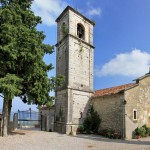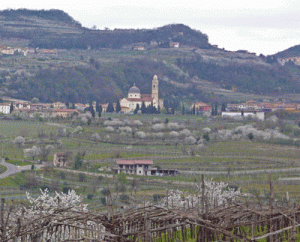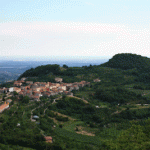
landscape of Valpolicella. Small towns that revolve around old houses and courtyards, old churches (the parish of Valgatara, Marano and San Rocco, the Romanesque church of San Marco Pozzo in Valgatara, San Giorgio di Purano, Sant’Eustacchio of Prognol, Santa Maria Valverde and Santa Cristina). Going Along the provincial road of Valgatara you can see the Venetian villas of Porta Rizzini and Lorenzi now Benati. There is a large number of appreciable rural courts as Castellani Court of Badin, a villa of the sixteenth century with dovecote and arcades, Court Bonazzi in Badin, Court Rugolin, Court Castello, Court Silvestri and Court Campagnola in Villa, just to name a few.
TERRITORY OF MARANO VALPOLICELLA
Hamlets: Pezza, San Rocco, Valgatara
Surrounding municipalities: Fumane, Negrar, San Pietro in Cariano, Sant’Anna d’Alfaedo
Altitude: 318 m s.l.m. – Population: 3.078 – Inhabitants name: maranesi
 Valpolicella. Mount Castelon climbs surrounded by the plains below. Marano Valpolicella deals with its territory throughout the valley that lies between that of the Progno Fumane and that of Progno Negrar, located in the heart of Valpolicella opens his territory around noon where are grown vines, cherry and olive trees too. It has about three thousand inhabitants scattered in a few village whose population was, until a few years ago, devoted mainly to agriculture. And here you find the famous Recioto and here, cherries are grown more popular all over the Veronese. The village of Valgatara collects most of the three thousand inhabitants of the municipality.
Valpolicella. Mount Castelon climbs surrounded by the plains below. Marano Valpolicella deals with its territory throughout the valley that lies between that of the Progno Fumane and that of Progno Negrar, located in the heart of Valpolicella opens his territory around noon where are grown vines, cherry and olive trees too. It has about three thousand inhabitants scattered in a few village whose population was, until a few years ago, devoted mainly to agriculture. And here you find the famous Recioto and here, cherries are grown more popular all over the Veronese. The village of Valgatara collects most of the three thousand inhabitants of the municipality.HISTORY OF MARANO VALPOLICELLA
The presence of man in the municipality of Marano Valpolicella dates back to the Lower Paleolithic with some flints found on Mount Noroni, then other sites findings of Ravazzol, Boschetti and Monte Per, we have many more testimonies of Eneolithic, the Copper Age. On the mountain Castelon, where there was a castle, a fortified village in a dominant position, they found the ruins of the Bronze Age, the Iron Age and the mount for the same were occupied by the Gauls, Celts, Veneti and Etruscans that they found shards and a fibula, an altar for wing San Rocco and a statue of idol in Pizzol. The arrival of the Romans in the second and first centuries BC is evidenced by various archaeological finds and toponymy. Its name derives from the late Latin Marianum meaning “land of Marius” which according to tradition was identified as Gaius Marius who would build the castle in the area Castelon in defense from Cimbri and Minerbe identified both the hamlet of San Rocco and the church of Santa Maria. The valley was part of the Pagus Arusnati, coinciding with the barbarian invasions of the Visigoths, Huns and Ostrogoths you are in the countryside and in the cities the spread of the Christian religion. Probably there were Longobards with the establishment of many vicus, as in the twelfth century Valgatara, assumed the role of rural communities. Here Federico della Scala in 1311 rebuilt the castle already existed in the eleventh century, proclaimed count and his jurisdiction ended with the destruction of the castle in 1325. Marano Valpolicella was struck by epidemics of the plague in 1576 and in 1630. Rich in churches and villas the Marano valley is one of the most beautiful in all of Valpolicella.
LOCAL PRODUCTS OF MARANO VALPOLICELLA
